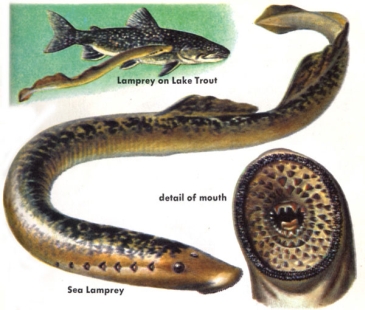Petromyzon marinus
Sea Lamprey
Synonym(s):
Class: Cephalaspidomorphi
Order: Petromyzontiformes
Family: Petromyzontidae

Photographer: unknown
Source: http://roferguson.wikispaces.com/Sea+Lamprey
Description
The sea lamprey (Petromyzon marinus) is an aquatic organism that lives part of its life sedimentary, free swimming, and parasitic. Sea lampreys have direct development, meaning the larvae look like smaller versions of adults, measuring about 6 inches. Adult lampreys are 18 to 24 inches long and can be identified by the characteristic circular mouth with rows of teeth surrounding a sucker. The specialized mouth allows sea lampreys to attach to hosts during their parasitic stage.
Ecological Threat: A portion of the sea lamprey life cycle is considered a parasitic stage, where it attaches to the scales of a fish and lives off the host fluids and blood. The common result is death for the host and the sea lamprey searches for another host with an estimated 40 pounds of fish killed during its lifetime. Sea lampreys target commercial fish such as trout, whitefish, and chub, which led to a large population decline in the 1940's and 1950's.
Biology: The lifespan of the sea lamprey larvae can range from 3 to 17 years in which the larvae is sedentary and not considered parasitic. From the months of September to May larvae mature and become free swimming adults in search of a host. The adult life span ranges from 18 to 20 months where it lives as a parasite before releasing the host and swimming upstream to spawn.
History: The sea lamprey was first discovered in Lake Ontario in 1835 and spread to the remaining four Great Lakes by 1947. Introduction was believed to have been facilitated by man-made shipping canals.
U.S. Habitat: The Great Lakes
Distribution
Native Origin: Atlantic Ocean
U.S. Present: The sea lamprey is found in the Great Lakes, but has the highest population density or hot zone in Lake Michigan and Lake Huron.
Sea Lamprey Distribution Map -- provided by USGS
Management
Current management technique involves applying lampricide called granular Bayluscide to Lake Michigan and Lake Huron, which are identified as hot zones for the sea lamprey. The lampricide is has been improved to target lampreys and their larva in the benthos without harming other benthic organisms. The treatment is scattered often by helicopter over the lake and sinks to the bottom. Developers believe this treatment should be effective in removing 85% of sea lampreys in non-native areas.
References
Bjerselius, Rickard, Weiming Li, John H Teeter, James G Seelye, Peter B Johnsen, Peter J Maniak, Gerold C Grant, Christine N Polkinghorne, and Peter W Sorensen. 2000. Direct behavioral evidence that unique bile acids released by larval sea lamprey (Petromyzon marinus) function as a migratory pheromone. Canadian Journal of Fisheries and Aquatic Sciences 57(3): 557-569.
Smith, B. R., and J. J. Tibbles. 1980. Sea Lamprey (Petromyzon marinus) in Lakes Huron, Michigan, and Superior: History of Invasion and Control, 1936–78. Canadian Journal of Fisheries and Aquatic Sciences 37(11): 1780-1801.
Youson, J. H.,and Y. C. Potter. 1979. A description of the stages in the metamorphosis of the anadromous sea lamprey, Petromyzon marinus L. Canadian Journal of Zoology 57(9): 1808-1817.
Internet Sources
http://www.umesc.usgs.gov/invasive_species/sea_lamprey.html
http://roferguson.wikispaces.com/Sea+Lamprey
 Texas Invasive Species Institute
Texas Invasive Species Institute